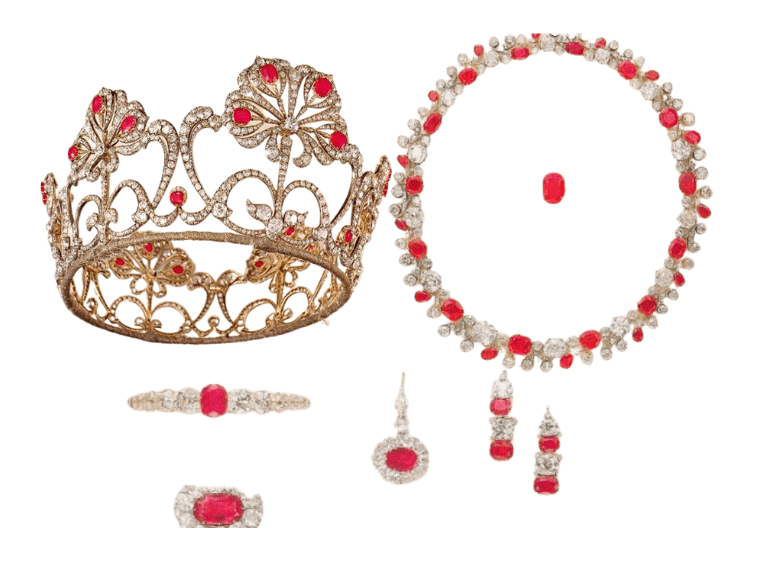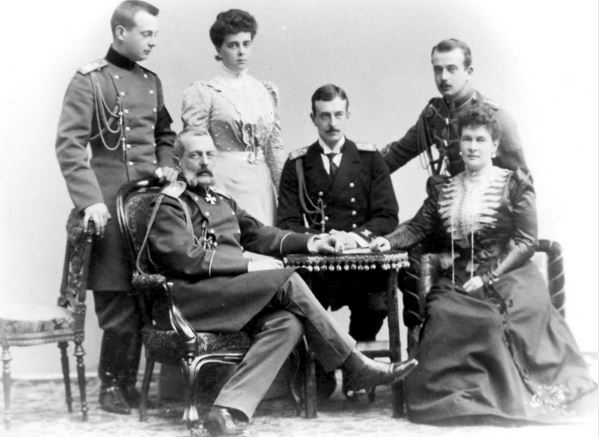
Her imperial Highness Grand Duchess Maria Pavlovna of Russia, The Grand Duchess Vladimir is considered one of the most important jewellery collectors in history. Born Duchess Marie of Mecklenburg-Schwerin she married the second son of the Russian Emperor Alexander II, Grand Duke Vladimir Alexandrovich in 1874.
Grand Duchess Maria became renowned as ‘the grandest of the grand duchesses’ and her home, the Vladimir Palace, became the centre of Russian aristocratic society. In 1902, Consuela Vanderbilt (who had married the 9th Duke of Marlborough) visited Maria Pavlovna in St. Petersburg :
‘She [Maria] had a majestic personality, but could be both gracious and charming. After dinner she showed me her jewels set out in glass cases in her dressing room. There were endless parures of diamonds, emeralds, rubies and pearls to say nothing of semi-precious stones such as turquoises, tourmalines, cat’s eyes and aquamarines.’ What a night that would be! It seems Russian etiquette called for the hostess show off her jewels to honoured female guests. Not what would be called tasteful by others but I would be OK with seeing jewellery at a dinner party!
Although she had a sumptuous collection of Sapphires, Emeralds, Diamonds and Pearls, Maria Pavlovna’s collection of Ruby jewellery does not seem to have been as extensive as its counterparts.






After the 1917 Russian Revolution, propaganda was spread that the Romanovs were ignorant and superstitious, and the reason the had so few ruby set jewels was because the royals thought they were unlucky and symbolised bloodshed.
This was of course, untrue.
Several of the Imperial Grand Duchesses received jewellery made with rubies, frequently as wedding gifts. Maria Alexandrovna, the sister-in-law of Maria Pavlovna, married Prince Alfred of the United Kingdom in 1874 and was given an exquisite suite of diamonds and rubies by Bolin, the Russian court jeweller.


Just as she had done with her Sapphires, Grand Duchess Vladimir took a number of her ruby and diamond pieces to Paris and deposited them with her good friend, Louis Cartier. These jewels were to be reset into a new tiara and corsage.
Paul Cheyrouze, an assistant to Cartier, handed Maria Pavlovna an itemised list of the gems that had been dismantled on June 1st, 1908, according to Jewelry of the Romanovs. These included:
Fourteen pins
Two necklaces
Single necklace
Amongst the jewels were a bracelet and brooch in the shape of a horseshoe that were documented in a rare jewellery album.


Maria Pavlovna owned the 5ct “Beauharnais” Ruby, which is supposed to have belonged to Empress Josephine, the first wife of Napoleon. This gem would be the tiara’s focal point.
The Octagonal stone was to be surrounded by the pear-shaped diamonds, square-cut rubies and oval ruby cabochons taken from the horseshoe brooch and the bracelet.



A large ruby and diamond corsage (brooch) was also created to compliment the new tiara. Featuring three of the rubies, the gems were surrounded with garlands of round diamonds.

In 1918, Russia finally exploded in to Revolution. Grand Duchess Vladimir fled to the Crimea leaving her jewels hidden in the Vladimir Palace, thinking she would return when the situation had improved.
Below, Prince Michael of Kent (Grand Duchess Vladimir’s Great Grandson) explains how when reality finally set in, she instructed her son Grand Duke Boris and her close friend Albert Stopford to retrieve her jewels.
Grand Duchess Vladimir passed away on the 6th September 1920 in Switzerland. Her vast jewel collection was divided amongst her children with her sons Andrei and Kyril inheriting the Rubies & Sapphires. Grand Duke Boris acquired her famous emeralds and her only daughter Elena received the Diamonds and Pearls.

Like many other exiled Romanovs, Grand Duke Andrei was forced to sell his mothers jewels in order to survive. The Rubies were returned to Cartier who would arranged their sale to Princess Anastasia of Greece (formerly Mrs Nancy Leeds) who interestingly, owned a tiara that Cartier had modelled after The Grand Duchess Vladimir’s


When her 2nd Husband died in 1908, Nancy became an enormously wealthy widow. She met and married the King of Greece’s youngest son Prince Christopher in Biarritz in 1914.
In 1921, Nancy’s 19-year-old son, William B. Leeds, Jr married Princess Xenia Georgievna of Russia (Prince Christopher’s niece.)
In a post from Greek Royal Jewels and Stories, the newspapers of the time reported:
“Never will bride have a richer wedding dowry than the young Princess Xenia of Greece on her marriage to Mr. William Leeds, the young son of the famous American millionaire’s widow, who is herself, by her second marriage, Princess Anastasia of Greece. Mrs Leeds has been in Paris for the last two weeks devastating the shops in the Rue de la Paix of their best and finest jewels. Diamonds, rubies, emeralds, sapphires – all perfect specimens of their kind – have been purchased regardless of price to form the wedding gift to her pretty future daughter-in-law.”

Sadly though, like so many of the Romanov treasures, the fate of these pieces remains unknown.
